
Ghana 2004
Page 2
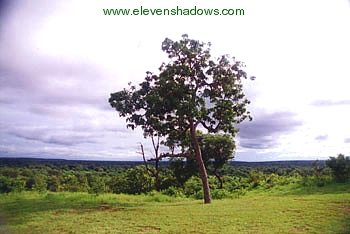 The
savannah at Mole National Park. The
savannah at Mole National Park. |
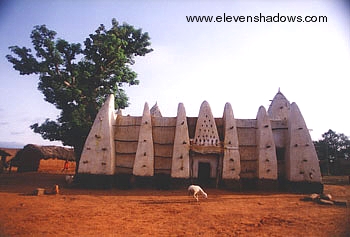 The
mysterious Larabanga, one of a half-dozen Sudanese style stick-and-mud
mosques, and allegedly the oldest structure in Ghana, and supposedly built
in 1421. The
mysterious Larabanga, one of a half-dozen Sudanese style stick-and-mud
mosques, and allegedly the oldest structure in Ghana, and supposedly built
in 1421. |
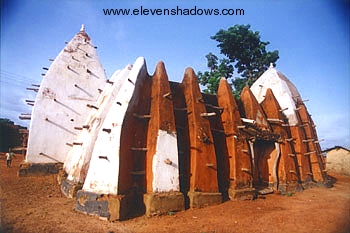 I
asked about how the sticks are replaced, assuming that the sticks were part
of the structure: I
asked about how the sticks are replaced, assuming that the sticks were part
of the structure:“They do not go all the way
through the wall,” “Really? They they’re just for decoration?” “Yes. When they rot, they are just taken out |
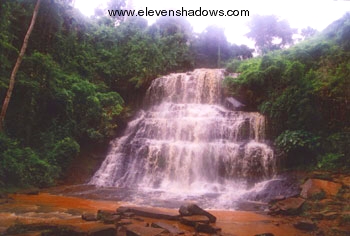 From
Larababanga, I rode on the back of a large lorry heading south to Kintampo,
which is in the middle of the country. About 20 of us sat on large bags of
grain, the wind whipping at our faces. Although admittedly a little
dangerous, it sure was fun. From
Larababanga, I rode on the back of a large lorry heading south to Kintampo,
which is in the middle of the country. About 20 of us sat on large bags of
grain, the wind whipping at our faces. Although admittedly a little
dangerous, it sure was fun.~~ Kintampo Waterfalls, Ashanti Region. |
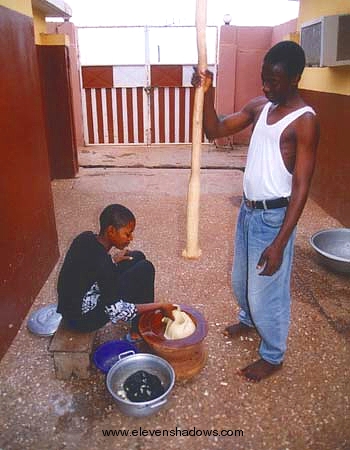 Making
the Ghanaian dish known as fufu, where one
basically takes cassava, plaintain or yam and mashes it into a pulp and then
cooks it to make gooey, doughy balls that is then submerged in a spicy soup
with either palm oil or groundnut (peanut) sauce. Making
the Ghanaian dish known as fufu, where one
basically takes cassava, plaintain or yam and mashes it into a pulp and then
cooks it to make gooey, doughy balls that is then submerged in a spicy soup
with either palm oil or groundnut (peanut) sauce. |
 Tano
Sacred Grove, outside Tanoboase, near the city of Techiman, featuring some
Star Trek-like sandstone formations and the former scene of The Ashanti Wars.
Also, the most powerful of the Ashanti Gods resides in the sacred grove. Tano
Sacred Grove, outside Tanoboase, near the city of Techiman, featuring some
Star Trek-like sandstone formations and the former scene of The Ashanti Wars.
Also, the most powerful of the Ashanti Gods resides in the sacred grove. |
 Advertisement
for a dentist in Techiman, Ashanti Region, sitting atop a chicken coop.
There are some times in which the gods smile upon us photographers. Advertisement
for a dentist in Techiman, Ashanti Region, sitting atop a chicken coop.
There are some times in which the gods smile upon us photographers. |
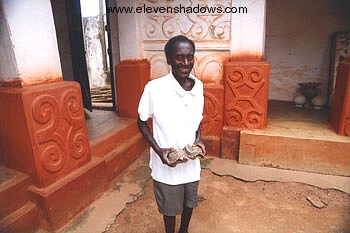 From
Techiman, I proceeded south to Kumasi, then heading east to Ejisu. From
Techiman, I proceeded south to Kumasi, then heading east to Ejisu.
I was interested in Ejisu because it was the birthplace
and home of Yaa Asantewaa, the Queen Mother who instigated the Ashanti
attack of Kumasi Fort against the British in 1900, and is the home to
numerous Abosomfie shrines, including the refurbished Besease Shrine (left). |
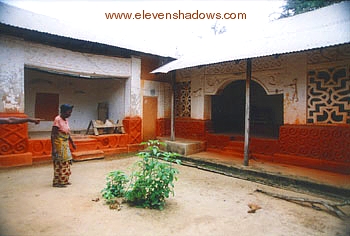 Another
look at the Besease Shrine. Another
look at the Besease Shrine. |
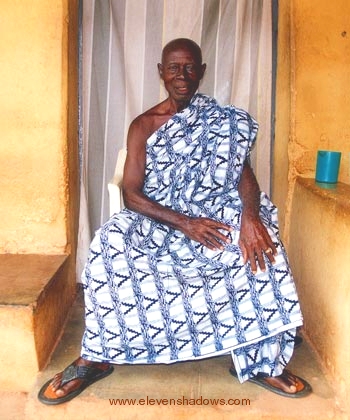 Agye
Kwabena Adade, the 96-year old storyteller of Adaku Jashi Shrine. Agye
Kwabena Adade, the 96-year old storyteller of Adaku Jashi Shrine.The Ashanti Storyteller of Adaku Jashi Shrine Adaku Jashi (Adarko Jachie) I had a fantastic experience visiting Adaku Jashi Shrine, near the village of Ejisu, although not for the reason I that initially drew me here. I had come to see a flamboyant dreadlocked fetish priest who careened wildly about during ritual ceremonies. This sounded exciting!! However, when I stopped at a roadside vendor to purchase a libation to honor the priest, a young man told me that the elderly priest was no longer at the shrine. Although disappointed, I continued to the shrine, with the young man now accompanying me. This young man, Hon Osei Bonsu, turned out to be the councilman of Adaku Jashi, and at 25, is the youngest councilman in all of Ghana. The shrine was beautiful. I asked a few questions about its origins. The councilman said that a village elder knew the answers. We stopped at Agye Kwabena Adade’s home, who at 96 years of age was the oldest man in Adaku Jashi. He was happy to receive us and tell us the history of Adaku Jashi Shrine while munching on tea and biscuits. Incredibly, after he finished the fantastic tale of its origin, he said that I was the first foreigner to ever hear this story! I was flabbergasted since UNESCO had declared the nearby Besease Shrine a World Heritage Site and had visited Adaku Jashi and other shrines in the area, and at 96 years of age, he would have had plenty of opportunity to tell someone about this. “You haven’t told this story to even UNESCO or university researchers?” I asked. “If they had asked, I would have told them,” he replied. The councilman said that this was the first time he had heard the story as well. After hearing the tale, we both walked away smiling, feeling quite honored to have heard the history of Adaku Jashi Shrine! Agye Kwabena Adade said that I could share the story with other foreigners, and so below is the story, as translated from Ashanti by the councilman. |
|
THE HISTORY OF ADAKU JASHI
SHRINE (Adarko Jachie Shrine) One of the elders, Chief Akono, caught a glimpse of a shining golden object near the shore of the river. It gleamed majestically despite the rain and the mud. Mystified, he immediately went to tell the others. Intrigued, the King asked Chief Akono to bring the object to him. However, when Chief Akono tried to pick up the golden object, he nearly burned his hand because it was blazing hot to the touch. Undeterred, The Chief grabbed some nearby leaves, managed to carefully pick it up, and began his walk to Adaku Jashi village. However, when he entered the village, something most unusual occurred. A spirit, which inhabited the golden object and somehow causing its extreme heat, flew out and entered Chief Akono. The chief immediately stopped speaking. People quickly summoned a fetish priest named Tano from a neighboring village. Upon his arrival, Tano realized that Chief Akono was possessed by the spirit from the golden object, and informed the villagers that Chief Akono was to become Adaku Jashi’s first fetish priest. For seven days after the spirit entered him, Chief Akono did not speak. On the eighth day, the spirit spoke through Chief Akono, announcing that his name was Akwasi Sima. Akwasi Sima inhabited the chief for thirty years, until the chief passed away. Upon Chief Akono’s passing, the spirit entered the body of another man named Ossei Komfo. Through Ossei Komfo, the spirit asked one of the builders of Adaku Jashi, Kwaku Sarfo, to organize the men in the village to build the shrine of Adaku Jashi. Other Information: The fetish priest usually chose Sunday to perform in an effort to adapt to the Christian day of worship. Sometimes, Friday was also used to adapt to Islamic customs. |
| Still buzzing with the excitement of my trip to Adaku Jashi Shrine, I took a taxi to see another shrine, the Edwanase Shrine. A man came out and wanted money for me photographing the exterior. After a while, I grudgingly gave him a small amount. He took it and, as he walked off, muttered something about going off to get a beer. |
 After visiting shrines in the Ejisu
area, I went to Kumasi for the day.
I wandered through their central
market, the largest outdoor market in
West Africa (it's monstrous!). And
I saw the Royal Palace and the
Cultural Center Museum,
both of which hadfascinating artifacts of the Ashanti. After visiting shrines in the Ejisu
area, I went to Kumasi for the day.
I wandered through their central
market, the largest outdoor market in
West Africa (it's monstrous!). And
I saw the Royal Palace and the
Cultural Center Museum,
both of which hadfascinating artifacts of the Ashanti.~~ Left, an advertisement on the way to the Cultural Center, Kumasi. |
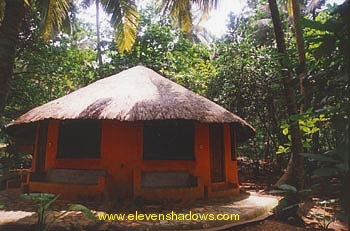 My thatched-roof bungalow at the Ankobra Beach Resort, a
stunning beach resort with white sand beaches and tall coconut palm trees
near Axim. My thatched-roof bungalow at the Ankobra Beach Resort, a
stunning beach resort with white sand beaches and tall coconut palm trees
near Axim.I took a first-class sleeper car from Kumasi to Takoradi, at the coast. I nicknamed this The Obruni Express ("obruni" = "foreigner" in Ghana) because the first-class sleeper car was mostly filled with foreigners. And it had a shower on board, a welcome relief after spending the entire day walking for miles and miles around the sweaty, exhaust-filled streets of Kumasi. I headed for the Ankobra Beach Resort (at right). Round thatched-hut bungalows with sculptured rock showers and an absolutely pristine, beautiful coconut palm beach. Absolutely gorgeous. Were this Tahiti or Mexico, my room would have been several hundred dollars per night, maybe more if other places had the typical Ghanaian friendliness and service. Instead, I paid $32. Small wonder that in nearby Busua, Europeans and North Americans are starting to purchase land and build little hotels. |
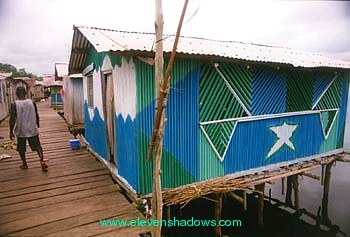 Nzulezo
Stilt Village, near Benin, close to the western border of Côte d'Ivoire. Nzulezo
Stilt Village, near Benin, close to the western border of Côte d'Ivoire.
While fascinating, I found the village to be a bit depressing due to their dependence on tourism. And the problem, of course, is that there’s almost no tourism in Ghana. |
 At
home in the amazing Nzulezo Stilt Village, near Benin, close to the western
border of Côte d'Ivoire. At
home in the amazing Nzulezo Stilt Village, near Benin, close to the western
border of Côte d'Ivoire. |
 The
"main street" in Nzulezo. The ancestors of the people here are from Mali. The
"main street" in Nzulezo. The ancestors of the people here are from Mali. |
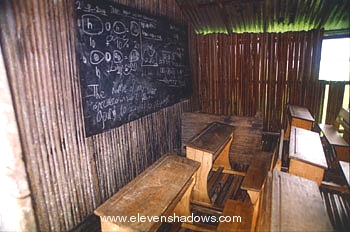 School
in Nzulezo Stilt Village. School
in Nzulezo Stilt Village. |
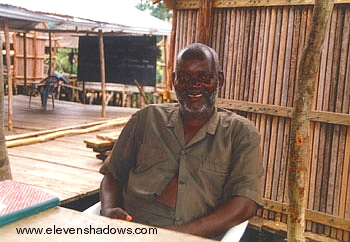 I
met the chief of the village (right). I
met the chief of the village (right).
He told me that his ancestors fled from Mali around the 14-15th Century on foot, following their god who had taken the form of a snake. Their enemy still close behind even though they had fled all the way to Ghana, the snake led them to the Amansuri Lagoon. Their enemy followed them, but the two rivers that converge on the lagoon suddenly swelled together, killing all of their enemies instantly. The Malian refugees felt that the lagoon was the one safe haven left to them, and chose to settle on the lagoon by constructing stilt houses. |
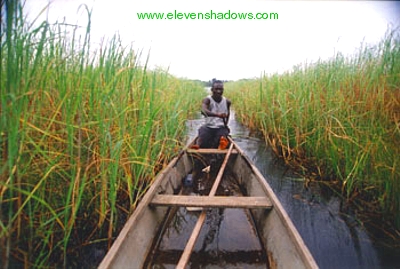 Paddling
our way through the inky black Paddling
our way through the inky blackwaters on the way to Nzulezo Stilt Village, near Benin, close to the western border of Côte d'Ivoire. |
Ghana 2004
Page 2
Ghana and
Frankfurt Home Page
Eleven Shadows Travel Page
Contact photographer/musician Ken Lee